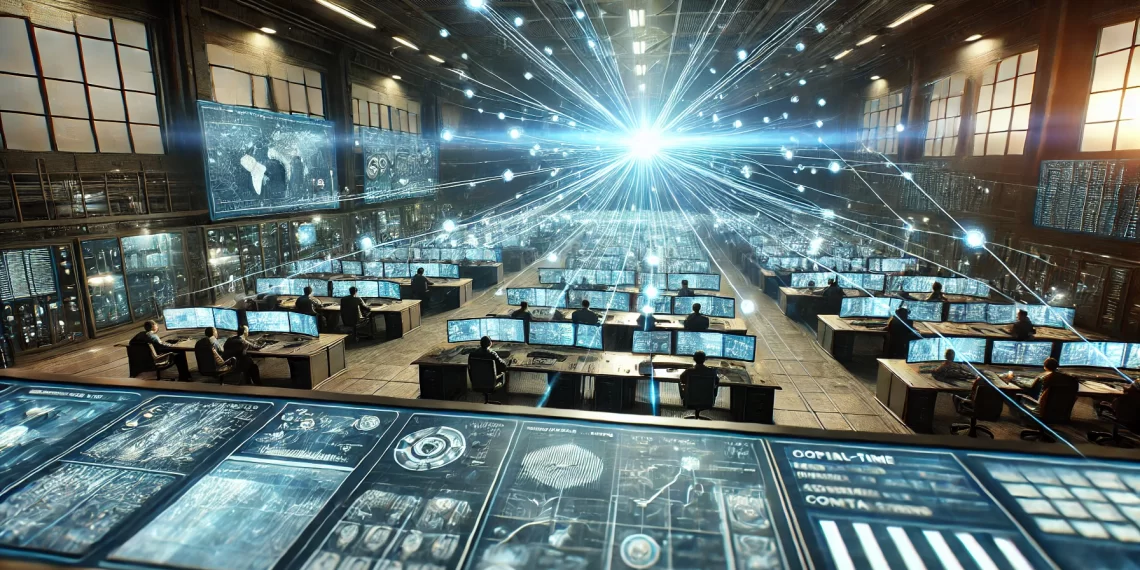As technological advancements in artificial intelligence (AI) and data processing continue to push the boundaries of modern computing, a revolutionary breakthrough known as diffraction casting is emerging as a solution to the power and speed limitations of today’s electronic-based systems. Originally designed to address the needs of AI and quantum computing, this new optical computing architecture could also play a critical role in the future of warfare, where speed, efficiency, and real-time decision-making are paramount.
Optical computing, which uses light waves to process information instead of traditional electronic signals, offers immense advantages for military applications. Unlike conventional computers that generate heat and consume large amounts of power, optical systems can process vast amounts of data simultaneously with minimal energy loss. This capability is essential in modern warfare, where real-time data analysis, communications, and AI-driven systems are increasingly determining the outcome of battles.
Diffraction casting, the latest advancement in optical computing, improves upon earlier designs like shadow casting by using the properties of light waves to perform complex logical operations. This new system could revolutionize how military computers operate in the future. By processing data more efficiently, diffraction casting could enhance the performance of AI systems tasked with identifying threats, analyzing battlefield environments, and making split-second decisions without requiring human intervention. In an era where autonomous weapons and drones are becoming more prominent, the ability to process data faster and more reliably could give militaries a decisive advantage.
In future combat scenarios, diffraction casting could be integrated into autonomous drones, which require fast, efficient computing to analyze their surroundings, identify targets, and execute precise missions. The ability to operate without generating excessive heat or requiring large amounts of power would allow these drones to remain in the field longer and perform more complex tasks. Additionally, the compact and efficient nature of this optical computing architecture could enable the deployment of powerful computing systems in smaller, lighter vehicles, further enhancing mobility and operational effectiveness.
One of the key advantages diffraction casting offers is the ability to process data in parallel. In a military context, this could enable the simultaneous analysis of multiple data streams from different sources, such as satellite feeds, drone footage, and ground sensors. The ability to process this data in real time would provide commanders with an accurate and up-to-date picture of the battlefield, allowing them to make more informed decisions quickly. Whether it’s coordinating troop movements, identifying enemy positions, or assessing potential threats, the speed and efficiency of diffraction casting could provide a critical edge in future conflicts.
Moreover, diffraction casting could play a pivotal role in cyber warfare, where data security and rapid processing are essential. By integrating optical computing into military cybersecurity systems, the U.S. could develop more advanced defenses against hacking attempts and data breaches. The inherent complexity of optical systems makes them more difficult to breach than traditional electronic systems, potentially offering a more secure infrastructure for military communications and operations.
This technology could also enhance quantum computing applications, which are expected to be a game-changer in warfare. Quantum computers, which can process data at exponentially higher rates than traditional systems, could revolutionize cryptography, enabling militaries to crack enemy codes and protect their own communications with unprecedented speed and security. By incorporating diffraction casting into quantum computing systems, the military could achieve new levels of processing power, allowing it to stay ahead of adversaries in both conventional and cyber warfare.
As the U.S. military continues to invest in advanced technologies to maintain its global superiority, diffraction casting could become a key component in next-generation defense systems. From improving the efficiency of AI-powered weapons to enhancing the capabilities of autonomous vehicles and quantum computers, this optical computing breakthrough represents the future of warfare. By dramatically reducing the energy requirements and increasing the speed of data processing, diffraction casting could ensure that the U.S. remains at the forefront of military innovation.
The race to develop more powerful and efficient computing systems is more than a technological competition—it’s about national security and maintaining a strategic advantage over potential adversaries. As AI-driven warfare becomes the norm and cyber threats continue to evolve, the ability to process massive amounts of data quickly and securely will be crucial. Diffraction casting could be the solution that enables the U.S. to meet these challenges head-on, ensuring that its military remains the most advanced and capable force in the world.








